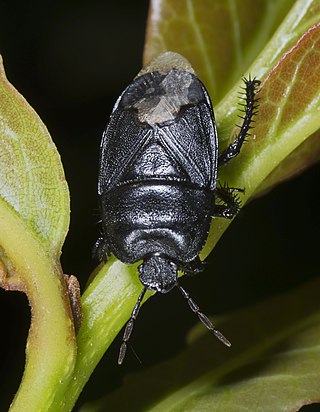
The Pentatomoidea are a superfamily of insects in the Heteroptera suborder of the Hemiptera order. As Hemiptera, they share a common arrangement of sucking mouthparts. The roughly 7000 species under Pentatomoidea are divided into 21 families. Among these are the stink bugs and shield bugs, jewel bugs, giant shield bugs, and burrower bugs.

Scutelleridae is a family of true bugs. They are commonly known as jewel bugs or metallic shield bugs due to their often brilliant coloration. They are also known as shield-backed bugs due to the enlargement of the thoracic scutellum into a continuous shield over the abdomen and wings. This latter characteristic distinguishes them from most other families within Heteroptera, and may lead to misidentification as a beetle rather than a bug. These insects feed on plant juices from a variety of different species, including some commercial crops. Closely related to stink bugs, they may also produce an offensive odour when disturbed. There are around 450 species worldwide.

The Miridae are a large and diverse insect family at one time known by the taxonomic synonym Capsidae. Species in the family may be referred to as capsid bugs or "mirid bugs". Common names include plant bugs, leaf bugs, and grass bugs. It is the largest family of true bugs belonging to the suborder Heteroptera; it includes over 10,000 known species, and new ones are being described constantly. Most widely known mirids are species that are notorious agricultural pests that pierce plant tissues, feed on the sap, and sometimes transmit viral plant diseases. Some species however, are predatory.

The Pentatomomorpha comprise an infraorder of insects in the true bug order Hemiptera. It unites such animals as the stink bugs (Pentatomidae), flat bugs (Aradidae), seed bugs, etc. They are closely related to the Cimicomorpha.

Acanthosomatidae is a family of Hemiptera, commonly named "shield bugs" or "stink bugs". Kumar in his 1974 world revision recognized 47 genera; now this number is 55 genera, with about 200 species, and it is one of the least diverse families within Pentatomoidea. The Acanthosomatidae species are found throughout the world, being most abundant in high-latitude temperate regions and in subtropical regions at high altitudes.

Cydnidae are a family of pentatomoid bugs, known by common names including burrowing bugs or burrower bugs. As the common name would suggest, many members of the group live a subterranean lifestyle, burrowing into soil using their head and forelegs, only emerging to mate and then laying their eggs in soil. Other members of the group are not burrowers, and live above the soil layer, often in close association with plants. Several species are known as agricultural pests.

The Corimelaeninae are a subfamily of shield bugs within the family Thyreocoridae. It has often been treated as a family (e.g.), but the name Thyreocoridae, published in 1843, has nomenclatural priority over Corimelaenidae, published in 1872.

The Thyreocoridae are a family of shield bugs, known by common names that include negro bugs or ebony bugs. Historically, a few authors have called this family "Corimelaenidae" (e.g.), but the name Thyreocoridae, published in 1843, has nomenclatural priority over Corimelaenidae, published in 1872. Other classifications have placed them as a subfamily within the broad family Cydnidae.
Macrotylus vanduzeei is a species of plant bug in the family Miridae. It is found in North America.
Hesperotingis fuscata is a species of lace bug in the family Tingidae. It is found in North America.

Isometopinae is a subfamily of jumping tree bugs in the family Miridae and are the only members of the Miridae to possess ocelli. The subfamily is split into five tribes. There are 42 genera and approximately 239 described species in Isometopinae.
Aidoneus is a genus of lace bugs in the family Tingidae. There is at least one described species in Aidoneus, A. dissimilis.
Lullius is a genus of lace bugs in the family Tingidae. There are about eight described species in Lullius.

Tingis is a genus of lace bugs in the family Tingidae. There are at least 130 described species in Tingis.
Reuteria fuscicornis is a species of plant bug in the family Miridae. It is found in North America.
Cantacaderinae is a subfamily of lace bugs in the family Tingidae. There are about 16 genera and at least 90 described species in Cantacaderinae.

Lasiochilinae is a subfamily of bugs, in the family Anthocoridae; some authorities place this at family level: "Lasiochilidae". It is most diverse in tropical areas, especially in the New World.

Helotrephidae is a family of aquatic bugs found mainly in the tropical regions with many species in the Oriental Realm and a few from Africa, Madagascar and South America. These bugs are found swimming or walking amid submerged vegetation in stagnant or slow moving, shaded freshwater in forest habitats. They are a sister group of the Pleidae.
Megarididae is a family of true bugs in the superfamily Pentatomoidea. The family consists of a single extant genus Megaris with about 16 species restricted to the Neotropical Realm and a fossil is known from Dominican amber.
Saileriolidae is a family of true bugs and is considered a basal or "primitive" family within the stink-bug lineage. They are found only in Asia. Originally included within the family Urostylididae, the group has recently been recognized as a separate family-rank lineage.












